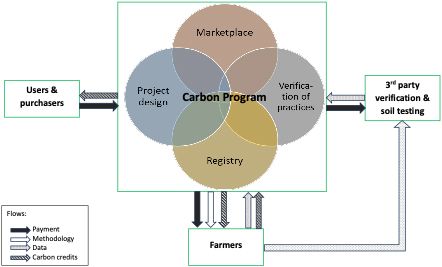Executive Summary
Kenyan farmers can increase their profitability and help mitigate climate change by implementing carbon farming, a sustainable agricultural technique that improves soil carbon sequestration. As companies seek to offset emissions, there is an increasing demand for carbon credits; groups such as VERRA and Gold Standard are assisting in the development of organized markets for carbon farming in Africa. Carbon farming can boost agricultural output, water retention and climate resilience. High initial costs, ignorance, difficulties accessing markets and land tenure concerns for farmers with precarious land ownership are some of its drawbacks.
Farmers and other interested parties will learn more about carbon farming and its financial advantages from this report.
Introduction and Background
Carbon farming is an agricultural technique that uses plants and soil to absorb and store carbon dioxide, enhancing soil fertility and reducing climate change effects. In Kenya, carbon farming methods include: agroforestry, regenerative agriculture, grassland management and soil conservation. This approach can offer local farmers significant economic potential through carbon credit schemes.
Data and Analysis
Carbon Generating Process Structure

Credit: Research Gate
Analysis: A carbon program is the hub of carbon credit generation, involving project design, verification, marketplace definition and carbon registry establishment. Agoro Carbon Alliance and Indigo collaborate with farmers and registries to generate and issue certified credits, involving synergies.
Key examples in Kenya:
a) With a focus on agroforestry and tree planting, Farm Africa's Acorn Initiative engages more than 4,000 smallholder farmers in the counties of Embu and Tharaka-Nithi and generates extra revenue through carbon sequestration.
b) The 45,000-hectare Kenya Agricultural Carbon Project (KACP) involves 60,000 farmers and enhances soil fertility and agricultural resilience while producing carbon credits via sustainable land management.
The Benefits of Carbon Farming for Kenyan Farmers
– Carbon Credit Sales: In voluntary carbon markets, farmers can make money by selling carbon credits. Farmers are compensated for sustainable land management through initiatives such as the Kenya Agricultural Carbon Project (KACP).
– Increased Crop Yields: Productivity and agroforestry revenue are both enhanced by healthy soils.
– Climate Resilience: By enhancing soil water retention, carbon farming lowers the danger of drought. Crop failure and revenue loss are prevented by diverse farming strategies.
– Funding & Grants: International organizations and non-governmental organizations provide funding for carbon farming projects. Initiatives such as the Vi Agroforestry Project help farmers implement sustainable farming methods.
Key Findings
Farmer Eligibility Requirements for Carbon Programs
To effectively engage in carbon programs, farmers must fulfill certain qualifying conditions, which include fulfilling particular carbon reduction activities. They include:
– Land ownership or the right to cultivate it
– The ability to adopt carbon-reducing techniques
– Not currently enrolled in another carbon program
– Located in eligible regions
Recommendations
Farmers should implement Soil Management Techniques:
a) Increase soil organic matter through crop rotation, less tillage and cover crops.
b) Incorporate trees into farming systems for carbon sequestration.
c) Use rotational grazing for cattle management to improve soil health and reduce greenhouse gas emissions.
Local farmers should participate in training programs and educational forums run by the government and important stakeholders.
References
Farm Africa's Acorn Initiative
Kenya Agricultural Carbon Project (KACP)
Carbon credit explained
Carbon farming
Carbon markets challenges & opportunities
What You Need to Know About the Measurement, Reporting, and Verification (MRV) of Carbon Credits









